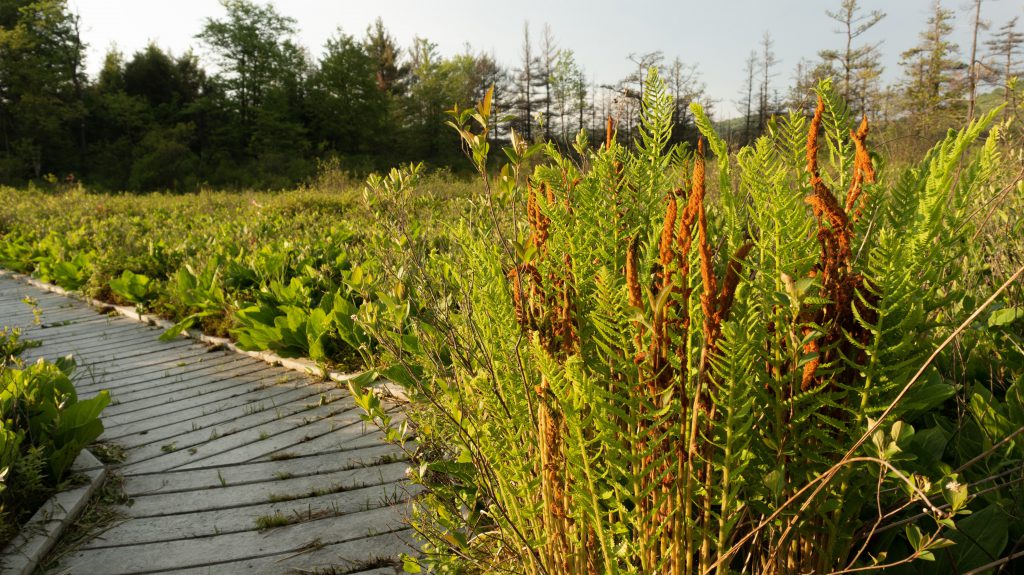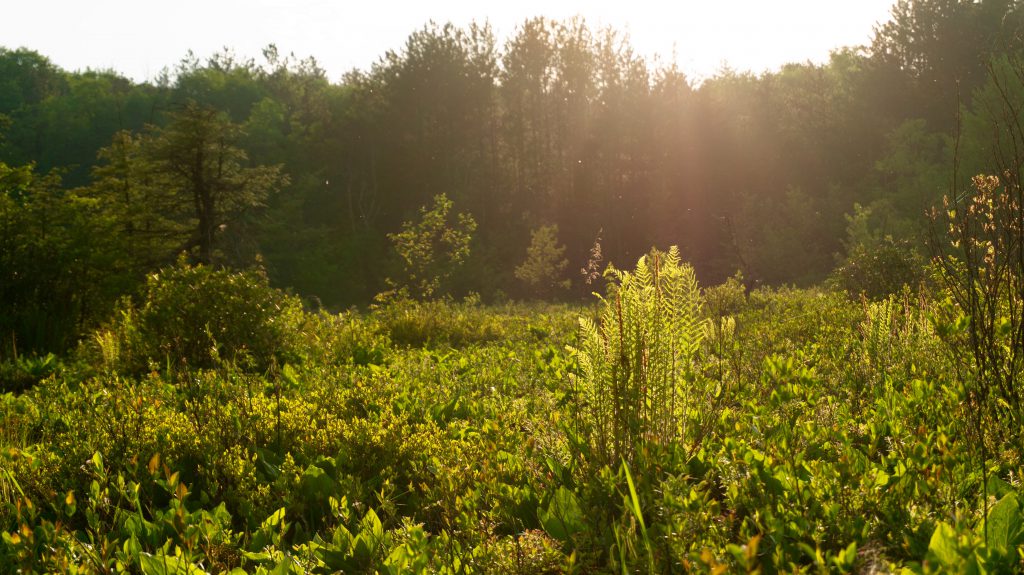Way Cool: Cranesville Swamp Offers a Glimpse into a Different Time and Climate
Most people come to western Maryland for the mountains — but Garrett County visitors who venture off the beaten path will find a remarkable and rare treasure tucked between the hills.
Cranesville Swamp Preserve is one of the last boreal bogs in the southeastern United States. In this small, bowl-shaped bog, a phenomenon known as a “frost pocket” creates a habitat more reminiscent of Alaska than Maryland. As weather patterns move east across the region, the hills surrounding Cranesville Swamp channel precipitation and chilled air into the valley, making the preserve one of the coolest locations in our state. Thanks to this unique climate, visitors can find lots of unusual plant and animal species in this out-of-place ecosystem and see what the landscape looked like 15,000 years ago as the last ice age receded.
The Power of Peat
The cool and damp setting of Cranesville Swamp is perfect for the formation of peat, a thick mat of vegetation that develops over thousands of years. Peat is made of compacted sphagnum moss and it is the breakdown of this moss that creates the acidic, nutrient-poor environment of a bog. These conditions result in a slow decay, which means that bogs like Cranesville provide a discernable record of climate and vegetation that can date back 10,000 years.
The acidic nature of a peat bog is also responsible for its unique botanical population—few trees can grow in the bog, giving the eastern hemlock, red spruce, and tamarack a chance to thrive. In fact, Cranesville Swamp contains the country’s southernmost tract of tamarack, conifers that shed their needles in winter and are found as far north as the Arctic Circle.
Speaking of arctic, the spongy mat of the peat itself can have a chilling effect; studies at Cranesville Swamp have found the peat to be 10 degrees cooler a foot below the surface.
The bog and the surrounding forest are home to other plants you won’t find elsewhere in Maryland. Sundew and pitcher plants—both carnivorous species—can be found in Cranesville Swamp. Small cranberry and creeping snowberry, threatened and endangered respectively, grow here as well.
In addition to special flora, Cranesville Swamp also provides a habitat for some very special fauna. You may see the endangered bog copper butterfly, which feeds exclusively on cranberry nectar, flitting around the marshy landscape. While you’re looking up, keep your eyes peeled for the rare Nashville warbler and saw-whet owl, the smallest owl in North America.
If you’re very patient (and very lucky) you may spot a southern water shrew. These semi-aquatic animals are voracious eaters who use echolocation to find their food and prefer a meal of small snails and insects.
Lots of Love
Perhaps more impressive than the ecology itself are the lengths that have been taken to preserve this unique place. In 1965, the swamp became one of the first National Natural Landmarks designated by the National Park Service. The National Audubon Society has named it an Important Bird Area. It was one of the Nature Conservancy’s earliest projects, and the group still owns and manages the site today, working closely with the department’s Natural Heritage Program to promote and protect it.
Thanks to these efforts, Cranesville Swamp is thriving today. While it had been miraculously spared by the pervasive logging that took place in western Maryland at the turn of the last century, the 1,774-acre site was in need of some love. The Nature Conservancy has worked to restore native plants, including the red spruce, which once dominated the landscape in and around the bog.
Since 2002, The Nature Conservancy has planted 40,000 of the these evergreen trees, which offer aesthetic beauty as well as ecological balance.
“Spruce soils sequester more carbon than most other soil types, including tropical rainforest,” says Dr. Deborah Landau, a conservation ecologist with the Nature Conservancy. As climate change continues to threaten delicate areas like Cranesville Swamp, large forests of trees like red spruce may help slow that process.
See the Swamp
Cranesville Swamp Preserve is open to the public and is one of few places where you can access and explore a frost pocket ecosystem. The Nature Conservancy maintains five trails in the preserve, each no longer than two miles. The 1,500-foot boardwalk bisects the wettest part of the bog and provides for some of the most picturesque views. As the name implies, the swamp can be wet and muddy, so be sure to wear sensible shoes and apply tick protection.
An audio tour is available for download on the Nature Conservancy’s website if you would like to learn more about the notable landmarks, species, and history of the area.
North of Frostburg, the Conservancy also manages Finzel Swamp, a similar boreal bog and the headwaters of the Savage River where you’ll find woodland jumping mice and salamanders.
dnr.maryland.gov/wildlife/Pages/NaturalAreas/Western/Cranesville-Swamp.aspx
Ashley Stimpson is a freelance outdoors writer. Appears in Vol. 22, No. 4 of the Maryland Natural Resource magazine, fall 2019.




 1-888-373-7888
1-888-373-7888 233733
233733